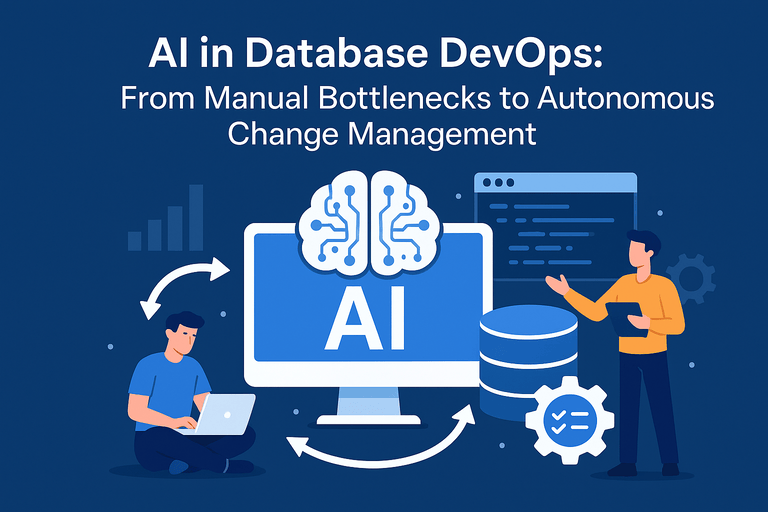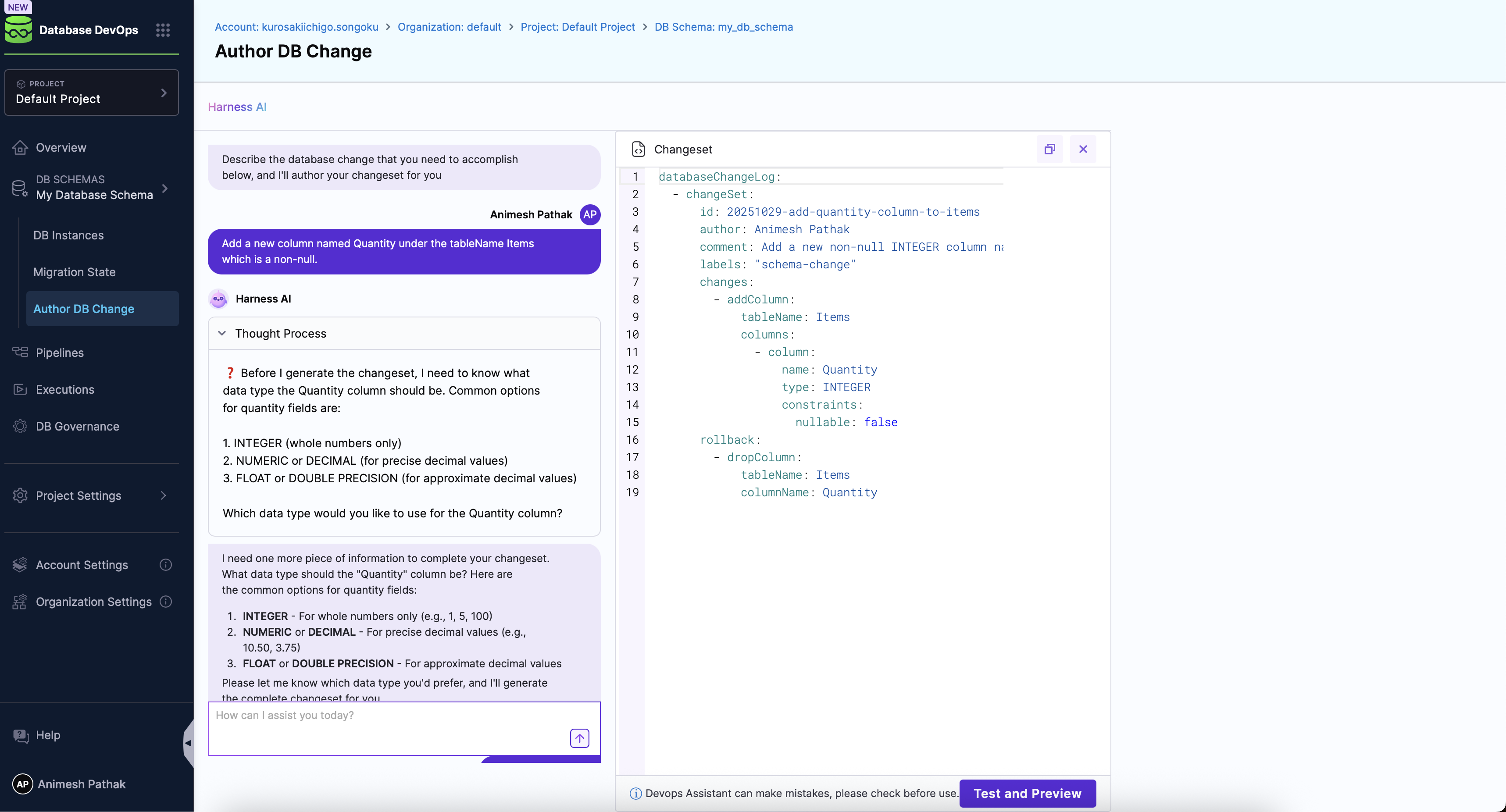
AI is transforming Database DevOps from manual scripting to intelligent automation. With Harness’s AI-powered migration authoring, teams can generate, validate, and deploy schema changes faster, all while maintaining compliance and control. This marks a new era of precision, safety, and speed in database delivery.
In the last decade, application DevOps has revolutionized, and automated testing, continuous integration, and seamless deployment pipelines have become standard practice. But when it comes to Database DevOps, progress has lagged. Migrations still require manual scripts, schema changes often rely on human-crafted SQL Scripts, and production rollouts are high-risk events.
Harness has brought AI-native automation to the last mile of DevOps - the database. With AI-Powered Database Migration Authoring, developers can now describe schema changes in natural language and instantly receive compliant, production-ready migrations complete with rollback and governance
That’s where AI comes in. By harnessing natural language processing, intelligent schema parsing, and predictive analytics, AI can now generate, modify, and optimize database changes automatically - cutting down delivery times and reducing the risk of human error.
In this blog, we’ll explore the emerging role of AI in Database DevOps, showcase real-world AI-powered tooling like the AI Changeset Generator, and discuss how teams can prepare for a future of autonomous change management.
The Challenges of Traditional Database DevOps
Despite significant advances in DevOps culture, the database remains one of the least automated components of modern software delivery. Common challenges include:
- Manual Changelog Authoring - Writing migration changelogs by hand is time-consuming, requires deep syntax knowledge, and is prone to typos or semantic errors.
- Slow Feedback Loops - Developers often wait for DBAs to review changes, creating bottlenecks that slow the entire CI/CD pipeline.
- High Risk of Production Failures - A single incorrect migration can bring down critical systems, and rollback scripts are often an afterthought.
- Limited Tool Intelligence - Popular open-source tools like Liquibase OSS are excellent for structured change tracking, but they lack native AI capabilities, meaning the developer is still responsible for authoring every migration.
- Complex Multi-Environment Management - Coordinating schema changes across dev, staging, and production environments introduces drift, conflicts, and unpredictable behaviors.
These pain points become especially acute in AI -driven projects where schema adjustments can be needed multiple times a day.
How AI is Reshaping Database DevOps ?
The introduction of AI into Database DevOps workflows unlocks entirely new capabilities:
- Natural Language to Changelog - Describe a schema change in plain English, e.g., “Add a column named email to the users table”, and get a production-ready changeset instantly.
- Context-Aware Suggestions - AI can analyze the existing schema and changelog history to ensure new migrations are consistent and avoid conflicts.
- Environment-Specific Changes - Target changesets for dev, staging, or prod environments using Liquibase-style contexts, ensuring precise deployments.
- Predictive Rollback Strategies - LLM can suggest the most likely rollback steps in case of a failed deployment.
- Automated Compliance Checks - AI can flag non-compliant changes before they reach production, helping meet regulatory requirements without extra manual review.
These capabilities allow teams to move away from reactive, manual processes and toward proactive, automated, and safer database change management.
AI-Powered Database Migration Authoring in Harness Database DevOps
AI-Powered Database Migration Authoring within Harness Database DevOps :
- Describe changes in plain language. The AI interprets your intent and generates precise, production-ready migrations instantly.
- Augment existing changelogs automatically. Harness AI analyzes your existing migration history from Git and seamlessly appends new changes in the correct order, no manual copy-paste required.
- Target specific environments. Generate migrations with Liquibase style contexts like dev, staging, or prod for selective and controlled rollouts.
- Stay CI/CD-ready. Every AI-authored migration aligns with Harness pipelines, governance policies, and deployment workflows for end-to-end reliabilit
Ready for CI/CD - The generated changelogs are fully compatible with modern pipelines, enabling automated deployments without extra formatting work.
Example Workflow:
- Step 1 - Developer describes a change in natural language in Harness.
- Step 2 - Harness AI analyzes the schema and governance rules.
- Step 3 - Generates a compliant migration with rollback.
- Step 4 - Test and Preview the generated changelog with the new changeset tagged specifically for production.

In the above example:
- The left panel is where you describe the desired change and optionally add existing changelog content.
- The right panel displays the AI-generated, ready-to-use changeset.
Comparison with Traditional OSS Tools
Unlike Liquibase/Flyway, which require manual authoring and lack governance context, Harness embeds AI generation, rollback, and policy validation directly into the CI/CD pipeline This means:

In other words, AI doesn’t replace the robust migration frameworks we know and trust. it helps user by empowering them with easy.
The Road Ahead – Fully Autonomous Database DevOps
The next frontier is self-managing databases, where AI doesn’t just write migrations - it deploys them, monitors for issues, and rolls back or fixes changes automatically.
We envision:
- Continuous Schema Learning - AI models that adapt to your organization’s coding and data patterns over time.
- Self-Healing Deployments - Automatic rollback or schema patching when anomalies are detected in production.
- Integrated Data Governance - AI that ensures every schema change aligns with security, compliance, and business rules in real time.
This isn’t science fiction - the building blocks already exist, and tools like the Harness AI-Powered Database Migration Authoring are the first step toward that reality.
Conclusion
Harness Database DevOps turns the database from a bottleneck into an accelerator. With AI-Powered Database Migration Authoring, every change is safe, compliant, and fully auditable bringing the same automation and confidence to the database that CI/CD brought to applications.
If you’re ready to experience the benefits firsthand, try the Harness Database DevOps
Frequently Asked Questions
1. Can the AI Changeset Generator work with my existing changelog files?
Absolutely. You can paste your current changelog content into the tool, and the AI will intelligently insert the new changeset while preserving your existing migration history. This prevents duplication and ensures that the migration order remains intact.
2. How does environment-specific changeset generation work?
When you specify a target environment (for example- dev, staging, or prod), the tool automatically adds a context attribute to the changeset. This enables selective execution of migrations depending on the deployment target, ensuring that environment-specific changes don’t inadvertently impact other environments.
3. What database technologies are supported?
The generator produces changesets in a Liquibase-compatible format (YAML/XML/JSON/SQL), making it suitable for any database that Liquibase OSS supports. If you’re already using Liquibase OSS, you can drop the generated files directly into your workflow with minimal setup.
4. Does the tool validate or detect conflicts in changelogs?
Yes. When working with an existing changelog, the AI will scan for similar changes (e.g., duplicate table creation, repeated column additions) and adjust the new changeset to avoid conflicts. This makes it safer to iterate in multi-developer environments where changes are happening in parallel.
5. Does Harness support governance and rollback automatically?
Yes. Every AI-authored migration includes rollback logic and passes through governance checks before deployment.

